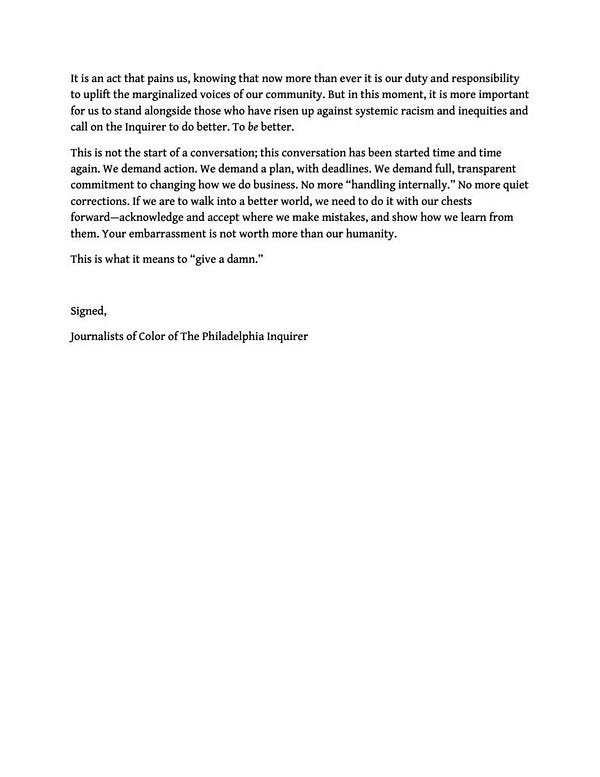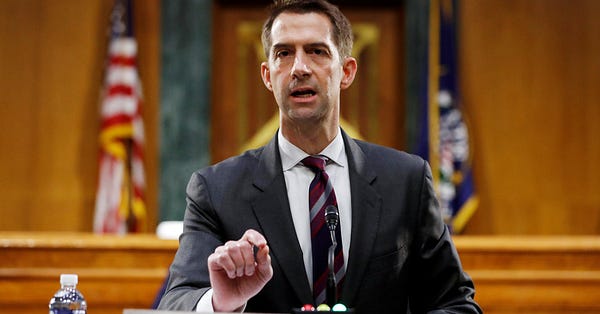Good morning. This little old newsletter was supposed to be a tiny slice of the internet where I could discuss the business of media, but as the last week or so has unfolded, it’s become less about the slinging of banner ads or the ways sales teams are trying to figure out how to sell at a time when they can’t take their clients to jeans parties, and more about the state of, well, us.
Today is no different.
Yesterday, two events, one at the Philadelphia Inquirer and the other at the New York Times, sparked outrage, highlighting how fraught our nation is at the moment, but also how decision making inside journalistic institutions have direct effects on society.
The Inquirer ran a headline about the destruction of buildings during a week of protests in the city: “Buildings Matter, Too.”

(Image via Inquirer)
The headline perverts the Black Lives Matter phrase, and in an apology posted online, the paper’s top editors write:
“The headline offensively riffed on the Black Lives Matter movement, and suggested an equivalence between the loss of buildings and the lives of black Americans. That is unacceptable.
While no such comparison was intended, intent is ultimately irrelevant. An editor’s attempt to capture a columnist’s nuanced argument in a few words went horribly wrong, and the resulting hurt and anger are plain.”
The apology also explained its editing and headline process, noting that this offensive headline was a systemic failure:
Stories typically go through two assignment editors before reaching the print desk, where copy editors weigh the merits of the story, and check for grammar, style and factual errors. It’s at that stage, when the print page is being created, that print headlines are written by copy editors. Typically, two print editors review headlines and pages before they are sent to the presses. Our review of this incident found that the process was followed, and the headline was created by one editor and read by another.
Today, journalists of color at the paper are calling in “sick and tired” after sending an open letter last night.



Ninety miles up I-95, an inferno.
The New York Times opinion section published an op-ed from Tom Cotton, a Senator from Arkansas, that essentially called for the deployment of the United States military into cities to clamp down on protests. Perhaps not unintentionally, the piece ran on the eve of the 31st anniversary of Tiananmen Square, when the Chinese government brought in tanks to squash protests.

(Image via Getty)
In parroting President Trump’s new found love affair with “law and order,” Cotton wrote:
“One thing above all else will restore order to our streets: an overwhelming show of force to disperse, detain and ultimately deter lawbreakers.”
Alliteration aside, this is dangerous. “This” is doing a lot of work here, so let me explain:
First: the content of Cotton’s piece is dangerous. At a time when the nation is on edge, having a Senator openly preen for the president (who may be looking for a new Secretary of Defense, who would then control the military) by arguing in favor of tyranny is a bridge too far.

Second: the content of Cotton’s piece should have not been published as an opinion, and instead, should have been turned into a news story. A sitting U.S. Senator advocating for military rule is news, not opinion.
Third: the rationale of Cotton’s piece is not new. Indeed, the day before, the New York Times ran the A1 headline: "As Chaos Spreads, Trump Vows to 'End It Now,'" causing its own brouhaha, which then changed the hed for the late edition to: “Trump Threatens to Send Troops into States.” Had he written this three days ago, maybe. But now it’s a grotesque sloppy seconds.
Fourth: the underlying reason for the protests is the systemic racism that built the United States and exemplified by the constant police brutality against unarmed black people. George Floyd was killed because of this. It’s the same reason Colin Kaepernick kneels; it’s not about disrespecting the flag but about protesting racism and racist policing. The rioting and looting that sparked from Floyd’s death can often be placed at the aggressive and militarized nature of the police, as they push peaceful protesters to violence, while providing cover for those seeking violence.
Cotton twists himself into knots arguing that “the rioting has nothing to do with George Floyd, whose bereaved relatives have condemned violence. On the contrary, nihilist criminals are simply out for loot and the thrill of destruction, with cadres of left-wing radicals like antifa infiltrating protest marches to exploit Floyd’s death for their own anarchic purposes.”
The New York Times (and others) reported that these are not true. Additionally, the opinion piece is riddled with lies that the newsroom had already debunked through vigorous reporting
Fifth: publishing the opinion piece puts black people, as well as New York Times reporters, in danger. Indeed, the paper’s staff took to Twitter to tweet just that. It has also put a few reporters into a bind.
The paper’s media reporter writes:
“Three Times journalists, who declined to be identified by name, said they had informed their editors that sources told them they would no longer provide them with information because of the Op-Ed.”
New York Times opinion editor, James Bennet, also took to Twitter, but to explain his rationale for publishing the piece.
We are at a moment where the press matters as much as any time in our history. Unforced errors, like poorly worded headlines or insensitive frames or serving as a mouthpiece for fascism, quickly erode whatever trust the media has left with the citizenry.
A 2019 Gallup poll has only 4 in 10 Americans trusting the news media; a 2020 Pew Research report found America is divided on the news sources they trust. News organizations need to make better decisions that allow them to implement their mission: to engage and inform a citizenry so that we, the people, can make informed decisions.

There used to be a role inside news organizations that spoke for the reader, helping the publication hold up its editorial integrity while adhering to journalistic ethics.
Incidentally, the New York Times eliminated its public editor role in 2017. The date? June 2.
If anyone at the paper is reading, I know a hirsute man who writes a newsletter and is looking for a gig …
John Fogerty, “Headlines”
Thank you for allowing me into your inbox. If you have tips, or thoughts about the newsletter, drop me a line.
Some interesting links:
Snap Says It Will No Longer Promote Trump’s Account (NYT)
8 Journalists on Reporting While Black, With the Weight of History on Their Shoulders (Glamour)
The NFL Is Suddenly Worried About Black Lives (The Atlantic)
While filming police violence has done nothing to stop it (MIT Technology Review)
Connected TV Usage Remains High as Covid-19 Restrictions Ease While Linear Drops (Adweek)
Exclusive data from Hulu breaks down the behaviors of streaming viewers in recent months and identifies 4 distinct categories (Business Insider)






Speed (rushing, not the drug), the press of deadlines, sheer exhaustion and a lack of seasoned editors can all be blamed in large part for errors like that made by The Inquirer, don't you think? The house rules should probably say "Avoid Flippant Heads." That would save the paper from itself when it's on autopilot, and keep it "on brand" (it's not the New York Post, after all.) I used to work in an ad agency that had that kind of rule. It's so easy to offend unintentionally; and always has been. Rules help you avoid offending.